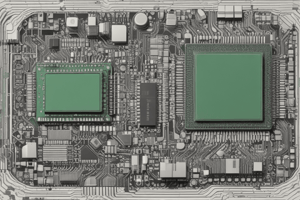Podcast
Questions and Answers
What is the specific combination of S0 and S1 for Halt mode in the 8085 microprocessor?
What is the specific combination of S0 and S1 for Halt mode in the 8085 microprocessor?
S0=1, S1=1
When does the microprocessor release the buses upon receiving the HOLD signal?
When does the microprocessor release the buses upon receiving the HOLD signal?
After the current machine cycle is over
What does a low WR' signal indicate in the 8085 microprocessor?
What does a low WR' signal indicate in the 8085 microprocessor?
Ready to write data to a selected memory or I/O location
How does the microprocessor determine if a peripheral device is ready for data transfer?
How does the microprocessor determine if a peripheral device is ready for data transfer?
What is the purpose of the HOLD signal in the 8085 microprocessor?
What is the purpose of the HOLD signal in the 8085 microprocessor?
What is the role of ALE in the 8085 microprocessor?
What is the role of ALE in the 8085 microprocessor?
How does ALE function during the first T state of a machine cycle?
How does ALE function during the first T state of a machine cycle?
What does IO/M' determine in the 8085 microprocessor?
What does IO/M' determine in the 8085 microprocessor?
When is an address on the address bus considered to represent an I/O device?
When is an address on the address bus considered to represent an I/O device?
What are the four distinct modes offered by S0 and S1 control signals?
What are the four distinct modes offered by S0 and S1 control signals?
Study Notes
Control Signals in the 8085 Microprocessor Pin Diagram
Control signals play a crucial role in managing the interactions between the microprocessor and external devices. In the case of the 8085 microprocessor, control signals facilitate the coordination of operations between the microprocessor and peripheral devices like RAM, ROM, and I/O ports. By understanding these control signals, we can better comprehend the behavior of the 8085 microprocessor within a larger computing system.
ALE - Address Latch Enable
ALE is an essential control signal in the 8085 microprocessor. As described in, ALE serves as an address latch enable signal. During the first T state of a machine cycle, ALE goes high and enables the lower eight bits of the address bus. If the value of the lower eight bits is 1, the lower eight bits become part of the address bus. Otherwise, the data bus is activated.
IO/M' - Input/Output Device Selection
IO/M' is another critical control signal in the 8085 microprocessor. This pin determines whether an address is intended for an input/output (I/O) device or for memory. When IO/M' is high (1), the address on the address bus represents an I/O device. In contrast, when IO/M' is low (0), the address on the address bus denotes a memory location.
S0 and S1 - Status Select
S0 and S1 are additional control signals that serve as status select pins. They offer four distinct modes: halt, read, instruction fetch, and write. As shown in, each mode corresponds to a specific combination of S0 and S1:
- S0=1, S1=1: Halt mode
- S0=0, S1=1: Reading mode
- S0=1, S1=0: Instruction fetching mode
- S0=0, S1=0: Writing mode
By monitoring these control signals, the microprocessor can initiate the appropriate operation based on the desired functionality.
WR' - Write Enable
When WR' goes low (as mentioned in), it signifies that the microprocessor is ready to write data to a selected memory or I/O location. This control signal ensures that the right operation is triggered at the right time.
READY - Peripheral Readiness Status
READY is a control signal used by the microprocessor to check whether a peripheral device is ready for data transfer or not. If READY is high (indicating that the peripheral is ready), the microprocessor can proceed with the data transfer. Otherwise, it will wait until READY goes high before continuing.
HOLD - Bus Release on Request
The HOLD signal indicates when another device has requested the use of the address and data buses. When this request is received, the microprocessor releases the buses after the current machine cycle is over. Once the other device has finished its operation, the processor regains control of the buses again.
Advantages and Disadvantages
Understanding the control signals in the 8085 microprocessor pin diagram and their functions allows us to appreciate both the advantages and disadvantages of this particular design. On one hand, the straightforward structure simplifies the implementation process and makes interfacing easier. However, limitations such as limited addressing capability due to its 8-bit architecture may pose challenges in certain applications. Additionally, the number of available I/O ports might be insufficient for systems requiring extensive input/output functionality.
Studying That Suits You
Use AI to generate personalized quizzes and flashcards to suit your learning preferences.
Description
Test your knowledge on the control signals of the 8085 microprocessor pin diagram. Learn about essential signals like Address Latch Enable (ALE), Input/Output Device Selection (IO/M'), Status Select (S0 and S1), Write Enable (WR'), Ready, and Hold, and understand their crucial roles in managing interactions between the microprocessor and external devices.





